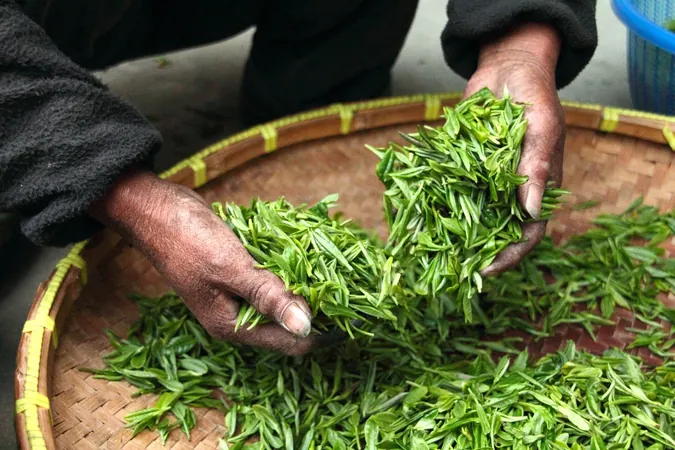
Unlocking the Power of Biofortification: The Key to Combatting Global Malnutrition!
2024-11-04
Author: Amelia
Unlocking the Power of Biofortification: The Key to Combatting Global Malnutrition!
Recent research has spotlighted biofortification as a groundbreaking, affordable, and sustainable approach to tackle global malnutrition by enhancing essential nutrient levels in staple crops. This initiative is gaining momentum thanks to a series of academic papers and a newly launched free online data dashboard.
The latest study, featured in Nutrition Research Reviews, systematically investigates the factors influencing the adoption of biofortified crops. Researchers found that the inherent benefits of these crops—such as improved nutrition and ease of production—play a crucial role in enticing farmers to adopt these newer varieties, especially when they understand the advantages over traditional crops.
Dr. Samantha Huey, a leading researcher at the Joan Klein Jacobs Center for Precision Nutrition, emphasizes the multifaceted impact of biofortified foods on various consumer demographics, highlighting the importance of understanding these food products from both a micro and macro perspective.
To ensure that this vital information reaches a broader audience, database developer Jesse Krisher collaborated with Dr. Huey and Dr. Saurabh Mehta to create a user-friendly online dashboard. This tool is designed to help users navigate complex data surrounding biofortification easily, as discussed in a recent Nature Food article.
Globally, approximately 2 billion people suffer from micronutrient deficiencies, with children and women of reproductive age being the most affected, particularly in low-income nations. Recent findings have underscored that many people around the world do not consume sufficient essential micronutrients, necessitating food-based strategies to encourage dietary diversity and complement other health initiatives.
Biofortification offers a solution by integrating enhanced nutrient crops into existing food systems, contingent upon farmers cultivating these new varieties and consumers opting to include them in their diets.
The comprehensive review, co-authored by Saiful Islam, dives into 41 studies focused primarily on orange sweet potato, one of the first biofortified crops developed, which boasts significantly higher beta-carotene levels compared to its white and yellow counterparts. Vitamin A deficiency, especially prevalent in regions like sub-Saharan Africa and South Asia, can lead to severe health issues, including vision loss and increased disease susceptibility.
Orange sweet potatoes not only provide higher levels of carotenoids but are also adaptable to various climate conditions, easier to cultivate, and appeal to consumers due to their appealing taste and appearance. The review also explored other biofortified crops like vitamin A cassava, high-iron beans, and vitamin A maize.
However, the research highlights significant barriers to adopting these crops, including local production challenges and insufficient knowledge among farmers about how to cultivate and process these varieties. Individual factors like capability, opportunity, and motivation also affect adoption rates, stressing the importance of understanding farmer and consumer characteristics to effectively promote biofortification.
Researchers propose that future studies should delve into the different stages of biofortification adoption and investigate less-studied crops and regions to broaden the scope of this essential initiative.
The collective effort between the Global Alliance for Improved Nutrition (GAIN) and the Joan Klein Jacobs Center has spurred this wave of reviews aimed at making critical information more accessible to implementers on the ground.
By utilizing comprehensive systematic reviews, researchers ensure a complete picture of the evidence surrounding biofortified foods rather than cherry-picking data to support a specific narrative. Dr. Huey notes that the goal is to close the gap in knowledge dissemination to those involved in implementing these interventions.
This collaborative research showcases how biofortified crops hold significant promise as an environmentally friendly solution to combatting widespread micronutrient deficiency, provided that adoption factors are thoroughly understood in specific contexts. Unlocking the benefits of biofortification could be pivotal in our fight against global malnutrition.









 Brasil (PT)
Brasil (PT)
 Canada (EN)
Canada (EN)
 Chile (ES)
Chile (ES)
 Česko (CS)
Česko (CS)
 대한민국 (KO)
대한민국 (KO)
 España (ES)
España (ES)
 France (FR)
France (FR)
 Hong Kong (EN)
Hong Kong (EN)
 Italia (IT)
Italia (IT)
 日本 (JA)
日本 (JA)
 Magyarország (HU)
Magyarország (HU)
 Norge (NO)
Norge (NO)
 Polska (PL)
Polska (PL)
 Schweiz (DE)
Schweiz (DE)
 Singapore (EN)
Singapore (EN)
 Sverige (SV)
Sverige (SV)
 Suomi (FI)
Suomi (FI)
 Türkiye (TR)
Türkiye (TR)
 الإمارات العربية المتحدة (AR)
الإمارات العربية المتحدة (AR)